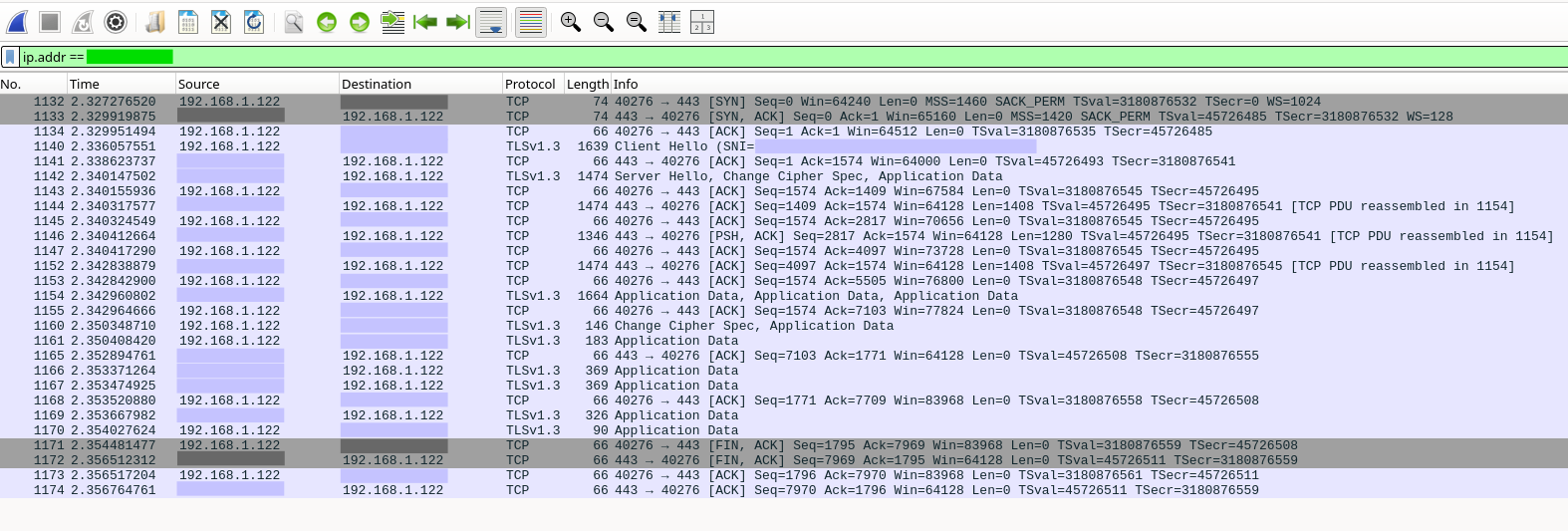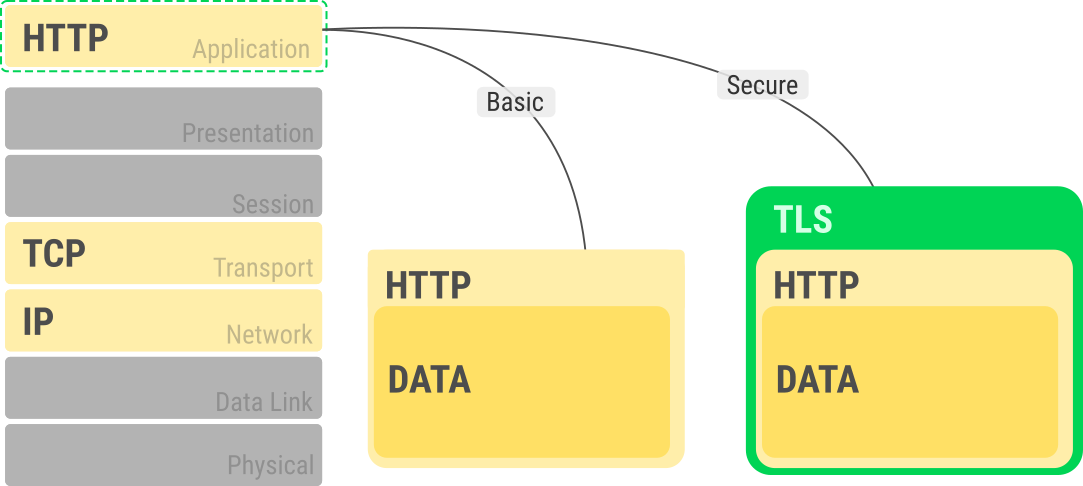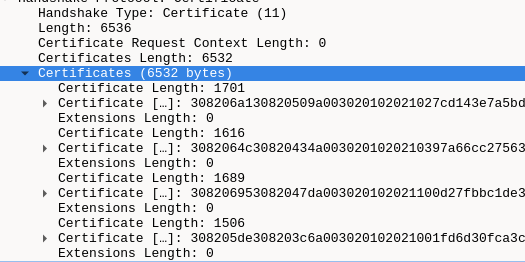Exploring rough TLS size overhead
This is a small exploration to see how much overhead does TLS add for a regular connection. We look into regular HTTP and how it changes with adding TLS to secure it.
Basic HTTP
Initially let’s start setting up some baseline and get values that we can compare with our other results. For this we will need a simple HTTP response without any encryption. For data I will use just simple string “abc”. It will be 4 byte body. Three charcters and ending newline character.
This 4 byte file is on a real production server. For this test I set up a separate nginx location specifically for static files. The locations are exact for both http and https requests without any redirection. Just raw static file serving.

This is whole duplex network communicationn to get this one 4 byte document. If we take just response from the server we will just 4 responses:
31 2.243422216 xx.xx.xx.xx 192.168.1.122 TCP 74 80 → 48488 [SYN, ACK] Seq=0 Ack=1 Win=65160 Len=0 MSS=1420 SACK_PERM TSval=3890739 TSecr=3139042754 WS=128
34 2.245724418 xx.xx.xx.xx 192.168.1.122 TCP 66 80 → 48488 [ACK] Seq=1 Ack=96 Win=65152 Len=0 TSval=3890741 TSecr=3139042756
35 2.246058111 xx.xx.xx.xx 192.168.1.122 HTTP 304 HTTP/1.1 200 OK (text/html)
38 2.248563653 xx.xx.xx.xx 192.168.1.122 TCP 66 80 → 48488 [FIN, ACK] Seq=239 Ack=97 Win=65152 Len=0 TSval=3890744 TSecr=3139042760
There is 14 bytes for ethernet. It is level 2 of OSI model and we don’t care about those as they are not transfered through internet. They are used just for local network. If we remove 14 bytes from each response we get a total of 454 byte response. 3 of them are just TCP “management” response used start and maintain connection. So real data response packet is 304 - 14 = 290 bytes. Of these 20 bytes are for IP header, 32 bytes for TCP header. This gives us 290 - 20 - 32 = 238 bytes. From these we get 234 bytes for HTTP headers and 4 bytes for our actual data.

For current example the largest part is HTTP header. It is 234 bytes and consist of these headers:
HTTP/1.1 200 OK
Server: nginx/1.26.3
Date: Tue, 25 Sep 2025 15:45:22 GMT
Content-Type: text/html
Content-Length: 4
Last-Modified: Sun, 20 Sep 2025 16:28:35 GMT
Connection: keep-alive
ETag: "68d96233-4"
Accept-Ranges: bytes
These headers are for more or less a default nginx setup for serving static files. The same server which serves php projects has 1KB header with additinal headers like setting cookies and etc. Neighboring server that serves a python project also has 1KB headers but those were mostly due to required HTTP security headers (this is just for comparison).
Secure connection
This is the default type for modern internet and all production communications should be measured and tested in this environment. It does not matter if you send HTML document for a webpage, send JSON for an iOS app or getting getting or sending email over IMAP/SMPT.

Now let’s try to look at the same data “abc” but for secure connection. Our data is still 4 bytes and our HTTP headers is exactly the same as in first version 234 bytes.
Total send and recieve bytes: (74 + 74 + 66 + 1639+ 66 + 1474 + 66 + 1474 + 66 + 1346 + 66 + 1474 + 66 + 1664 + 66 + 146 + 183 + 66 + 369 + 369 + 66 + 326 + 90 + 66 + 66 + 66 + 66) - (27*14) = 11560 - 378 = 11182 (sent+recieve) bytes.
The client sent (excluding ethernet) a total of 2530 bytes. This includes connection, ack’s and closing. So for the whole session server sent back 11182 - 2530 = 8652 bytes.

Let’s try to figure out how much more overhead we get in this sample case. For insecure HTTP case we had 454 bytes total. If we remove all IP and TCP related bytes then we are left with 238 bytes (Data + HTTP).
Current raw estimate for response size is 8652 bytes. This includes IP and TCP and everything else. From the wireshark dump above we can see that there are 13 packets returned in total. The very first returned packet is taking 60 bytes: 20 bytes for IP and 40 for TCP. All the rest 12 packets used 20 bytes for IP and 32 bytes for TCP or 52 bytes of non data bytes per packet. So 8652 - 60 - (12*52) = 7968 bytes. There were 2 new session ticket packets with around 350 bytes each and our content were 238 bytes of HTTP+Data. Removing all this leaves us with about 6800 bytes. I am not counting all exact bytes (for example exact header size for TLS record) since we are not trying to get exact numbers but get rough ballbark numbers.
Since I have acess to this server I went and checked the certificate size in DER format. It was around 6.5KB in total or 4 certificate chain of about 1.5KB each. I ran the same query again but provided SSLKeys to let wireshark decrypt data to verify it and is it close enough to our estimates.

Overhead
As we can clearly see there is some overhead and it is big enough. Server hello is couple hundred bytes, there are some additional few hundred bytes for session ticket and the main overhead is added by certificate size. So we can estimate overhead just by looking at certificate chain. In our case it was 6.5KB. Probaly we could estimate it to be in the rage of 3KB-9KB.
Some sites and their certificate chain sizes:
- google.com - 5050 bytes
- www.google.com - 2506 bytes
- github.com - 3127 bytes
- wikipedia.org - 2760 bytes
- www.wikipedia.org - 2760 bytes
- yandex.com - 3700 bytes
- play.google.com - 5050 bytes